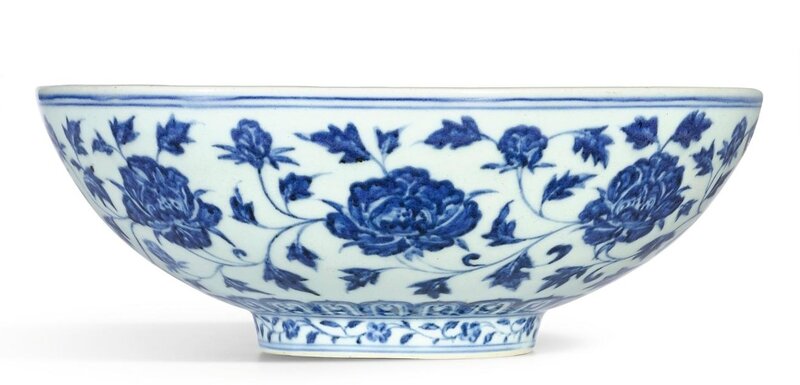An exceptional and brilliantly painted large blue and white 'peony' bowl, mark and period of Xuande (1426-1435)
Lot 3631. An exceptional and brilliantly painted large blue and white 'peony' bowl, mark and period of Xuande (1426-1435). Estimate 2,500,000 — 3,500,000 HKD. Unsold. Photo Sotheby's.
sturdily potted with shallow rounded sides rising from a slightly tapered foot, the exterior painted in rich and strong cobalt blue with eight large herbaceous peony blooms borne on a meandering leafy scroll, between a double-line border and a band of upright lappets, the footrim encircled by an undulating floral scroll, inscribed with a horizontal six-character reign mark below the rim; 26.3 cm, 10 3/8 in.
Provenance: Gulbenkian Museum of Oriental Art and Archaeology, Durham, no. L46 (on loan).
Christie's London, 9th November 2004, lot 132.
Notes: Bowls with the peony design like the present piece are very rare and belong to a most important and interesting type of blue and white porcelain from the Xuande period (1426-35). Bowls of this shape, whose deliberately sturdy construction with almost 1 cm thick walls are remarkable for their even potting and successful firing. They were made for only a short period of time in the Xuande reign and were not revived in the Qing dynasty, like most other early Ming shapes. Such bowls are almost always found with a Xuande reign mark below the rim, but can be painted with a variety of designs, such as flowering scrolls of both single and mixed species, lingzhi fungus, or double dragons.
The purpose of these shallow bowls, always undecorated on the inside, has not yet been definitely determined. It is discussed in the exhibition catalogue Chinese Porcelain. The S.C. Ko Tianminlou Collection, Hong Kong Museum of Art, Hong Kong, 1987, p. 53, where related Xuande bowls with varied designs are illustrated as pls. 25-27. It is suggested that such bowls were possibly used as dice bowls for playing dice in the palace; used by scholars as brush washers; used as fruit bowls; or for the popular game of cricket fights with the thickness of the bowls rendering them an ideal battlefield for combating crickets. Some examples indeed show an unusual amount of wear on the inside.
Peonies symbolise wealth and rank in Chinese culture, and are the subject of a latest exhibition at the Palace Museum, Beijing, held in early 2016, of objects of various materials from the imperial court collection decorated with peonies, together with actual peony flowers brought from Luoyang, Henan province, which has been famous for this plant for over a millennium. A catalogue of this exhibition is anticipated, and issue no. 6, 2016, of the magazine Forbidden City has been devoted to it. The peony appears at least as frequently in ceramic decoration as does the lotus, see Regina Krahl, ‘Plant Motifs of Chinese Porcelain, Examples from the Topkapi Saray Identified through the Bencao Gangmu, Part I’, Orientations, May 1987, pp. 52-65.
A few similar bowls are known in world-famous collections, one from the Qing Court collection and still in the Palace Museum, Beijing, illustrated in The Complete Collection of Treasures of the Palace Museum. Blue and White Porcelain with Underglazed Red (I), Shanghai, 2000, pl. 145; one in the National Palace Museum, Taiwan, published in the Museum'sCatalogue of the Special Exhibition of Selected Hsüan-te Imperial Porcelains of the Ming Dynasty, Taipei, 1998, cat. no. 48; one from the Sir Percival David Collection in the British Museum, London, illustrated in Margaret Medley, ‘Regrouping 15th Century Blue and White’, Transactions of the Oriental Ceramic Society, vol. 34, 1962-63, pl. 3a; and one from the collection of the School of Archaeology and Museology, Beijing University, included in the exhibition Treasures from a Swallow Garden, Arthur M. Sackler Museum of Art and Archaeology, Beijing, 1992, cat. no. 149.
Also known is an example from the Morrill Collection, sold at Doyle, New York, 16th September 2003, lot 88, exhibited at the Museum of Fine Arts, Boston, 1971, illustrated in Encompassing Precious Beauty: The Songzhutang Collection of Imperial Chinese Ceramics, Hong Kong, 2016, pl. 6; one sold in these rooms 7th May 2002, lot 565; and one formerly in the Riesco Collection, sold twice in our London rooms, 3rd July 1956, lot 62, and 11th December 1984, lot 321.

/https%3A%2F%2Fprofilepics.canalblog.com%2Fprofilepics%2F1%2F0%2F100183.jpg)
/https%3A%2F%2Fstorage.canalblog.com%2F03%2F02%2F119589%2F96711876_o.jpg)
/https%3A%2F%2Fstorage.canalblog.com%2F11%2F31%2F119589%2F94773502_o.jpg)
/https%3A%2F%2Fstorage.canalblog.com%2F20%2F83%2F119589%2F94772815_o.jpg)
/https%3A%2F%2Fstorage.canalblog.com%2F26%2F72%2F119589%2F75604929_o.jpg)
/https%3A%2F%2Fstorage.canalblog.com%2F59%2F60%2F119589%2F26458628_o.jpg)





/image%2F1371349%2F20240416%2Fob_2a8420_437713933-1652609748842371-16764302136.jpg)
/image%2F1371349%2F20240414%2Fob_83ee65_2024-nyr-22642-0954-000-a-blue-and-whi.jpg)
/image%2F1371349%2F20240414%2Fob_15808c_2024-nyr-22642-0953-000-a-blue-and-whi.jpg)
/image%2F1371349%2F20240414%2Fob_e54295_2024-nyr-22642-0952-000-a-rare-blue-an.jpg)